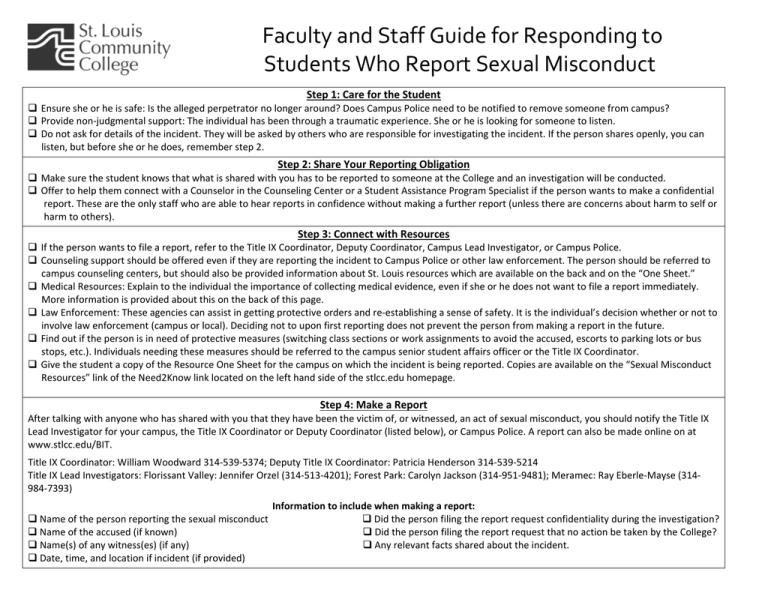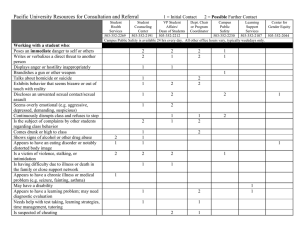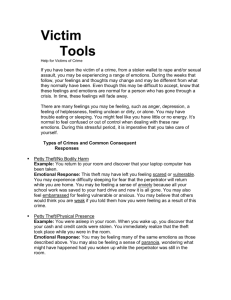
Faculty and Staff Guide for Responding to Students Who Report Sexual Misconduct Step 1: Care for the Student Ensure she or he is safe: Is the alleged perpetrator no longer around? Does Campus Police need to be notified to remove someone from campus? Provide non‐judgmental support: The individual has been through a traumatic experience. She or he is looking for someone to listen. Do not ask for details of the incident. They will be asked by others who are responsible for investigating the incident. If the person shares openly, you can listen, but before she or he does, remember step 2. Step 2: Share Your Reporting Obligation Make sure the student knows that what is shared with you has to be reported to someone at the College and an investigation will be conducted. Offer to help them connect with a Counselor in the Counseling Center or a Student Assistance Program Specialist if the person wants to make a confidential report. These are the only staff who are able to hear reports in confidence without making a further report (unless there are concerns about harm to self or harm to others). Step 3: Connect with Resources If the person wants to file a report, refer to the Title IX Coordinator, Deputy Coordinator, Campus Lead Investigator, or Campus Police. Counseling support should be offered even if they are reporting the incident to Campus Police or other law enforcement. The person should be referred to campus counseling centers, but should also be provided information about St. Louis resources which are available on the back and on the “One Sheet.” Medical Resources: Explain to the individual the importance of collecting medical evidence, even if she or he does not want to file a report immediately. More information is provided about this on the back of this page. Law Enforcement: These agencies can assist in getting protective orders and re‐establishing a sense of safety. It is the individual’s decision whether or not to involve law enforcement (campus or local). Deciding not to upon first reporting does not prevent the person from making a report in the future. Find out if the person is in need of protective measures (switching class sections or work assignments to avoid the accused, escorts to parking lots or bus stops, etc.). Individuals needing these measures should be referred to the campus senior student affairs officer or the Title IX Coordinator. Give the student a copy of the Resource One Sheet for the campus on which the incident is being reported. Copies are available on the “Sexual Misconduct Resources” link of the Need2Know link located on the left hand side of the stlcc.edu homepage. Step 4: Make a Report After talking with anyone who has shared with you that they have been the victim of, or witnessed, an act of sexual misconduct, you should notify the Title IX Lead Investigator for your campus, the Title IX Coordinator or Deputy Coordinator (listed below), or Campus Police. A report can also be made online on at www.stlcc.edu/BIT. Title IX Coordinator: William Woodward 314‐539‐5374; Deputy Title IX Coordinator: Patricia Henderson 314‐539‐5214 Title IX Lead Investigators: Florissant Valley: Jennifer Orzel (314‐513‐4201); Forest Park: Carolyn Jackson (314‐951‐9481); Meramec: Ray Eberle‐Mayse (314‐
984‐7393) Information to include when making a report: Name of the person reporting the sexual misconduct Did the person filing the report request confidentiality during the investigation? Name of the accused (if known) Did the person filing the report request that no action be taken by the College? Name(s) of any witness(es) (if any) Any relevant facts shared about the incident. Date, time, and location if incident (if provided) Medical Assistance Barnes‐Jewish Hospital Emergency Room 400 S. Kingshighway Blvd., St. Louis, MO 63110 314‐747‐3000 Missouri Baptist Medical Center 3015 North Ballas Road, St. Louis, MO 36131 314‐996‐5000 SSM Hospital – DePaul Health Center 12303 DePaul Drive, Bridgeton, MO 63044 314‐344‐6000 Individuals who have been the victim of sexual assault can go to any St. Louis area hospital for medical services A sexual assault exam includes preventative treatment for sexually transmitted infections, pregnancy, and evidence collection. The exam is conducted by a medical professional with advanced training and certification in conducting sexual assault exams. A police report is NOT required to receive medical assistance. Although a victim may not want to file a police report at the time of the incident, a sexual assault exam should be strongly considered to collect evidence in case it is decided to later file a report. Additional St. Louis Area Resources Crime Victim Advocacy Center of St. Louis St. Louis Circuit Attorney’s 539 N. Grand Blvd., Suite 400, St. Louis, MO 63103 Victim Services 24‐hour Hotline: 314‐652‐3623 1114 Market St., 4th Floor Legal Assistance: 800‐527‐1460 St. Louis, MO 63101 http://www.supportvictims.org/ Office Number: 314‐622‐4373 Life Source Consultants YWCA St. Louis Regional 119 Church St., Suite 219, St. Louis, MO 63135 Sexual Assault Center 24‐hour Crisis Line: 314‐524‐0686 3820 West Pine Blvd. Office Number: 314‐524‐4130 St. Louis, MO 63108 http://www.lifesourceconsultants.org/index.html Office Number: 314‐726‐6665 24‐hr Hotline: 314‐531‐RAPE (7273) Safe Connections www.ywcastlouis.org 2165 Hampton Ave., St. Louis, MO 63139 (click on “What We Do”, then 24‐hour Crisis Helpline: 314‐531‐2003 “Women’s Resource Center”) Office Number: 314‐646‐7500 http://safeconnections.org/ Definitions Dating Violence: Violence committed by a person— (A) who is or has been in a social relationship of a romantic or intimate nature with the victim; and (B) where the existence of such a relationship shall be determined based on a consideration of the following factors: (i) The length of the relationship. (ii) The type of relationship. (iii) The frequency of interaction between the persons involved in the relationship. Domestic Violence: Includes felony or misdemeanor crimes of violence committed by a current or former spouse or intimate partner of the victim, by a person with whom the victim shares a child in common, by a person who is cohabitating with or has cohabitated with the victim as a spouse or intimate partner, by a person similarly situated to a spouse of the victim under the domestic or family violence laws of the jurisdiction in which the crime of violence occurred, or by any other person against an adult or youth victim who is protected from that person’s acts under the domestic or family violence laws of the jurisdiction. Sexual Assault: Any sexual act directed against another person, without consent of the victim, including instances where the victim is incapable of giving consent. An offense that meets the definition of rape, fondling, incest, or statutory rape as used in the Uniform Crime Reporting (UCR) System of the FBI. Rape: The penetration, no matter how slight, of the vagina or anus with any body part or object, or oral penetration by a sex organ of another person, without consent of the victim. Fondling: The touching of the private parts of another person for the purpose of sexual gratification, without the consent of the victim, including instances where the victim is incapable of giving consent because of his or her age or because of his or her mental incapacity. Incest: Sexual intercourse between persons who are related to each other within the degrees wherein marriage is prohibited by law. Statutory Rape: Sexual intercourse with a person who is under the statutory age of consent. Stalking: Engaging in a course of conduct directed at a specific person that would cause a reasonable person to— (A) fear for his or her safety or the safety of others; or (B) suffer substantial emotional distress. Course of Conduct: two or more acts, including, but not limited to, acts which the stalker directly or indirectly, or through third parties, by any action, method, device, or means, follows, monitors, observes, surveils, threatens, or communicates to or about, a person, or interferes with a person’s safety. Reasonable person: a reasonable person under similar circumstances and with similar identities to the victim. Substantial emotional distress: significant mental suffering that may, but does not necessarily, require medical treatment or counseling. Sexual Harassment: Unwelcome sexual advances, requests for sexual favors, and other verbal or physical harassment of a sexual nature that tends to create a hostile or offensive education or work environment. Gender‐Based Harassment is included in Title IX which prohibits harassment against individuals who do not conform to stereotyped notions of masculinity and femininity. Sources: 42 U.S. Code § 13925 ‐ Definitions and grant provisions (http://www.law.cornell.edu/uscode/text/42/13925); http://www.eeoc.gov/laws/types/sexual_harassment.cfm


